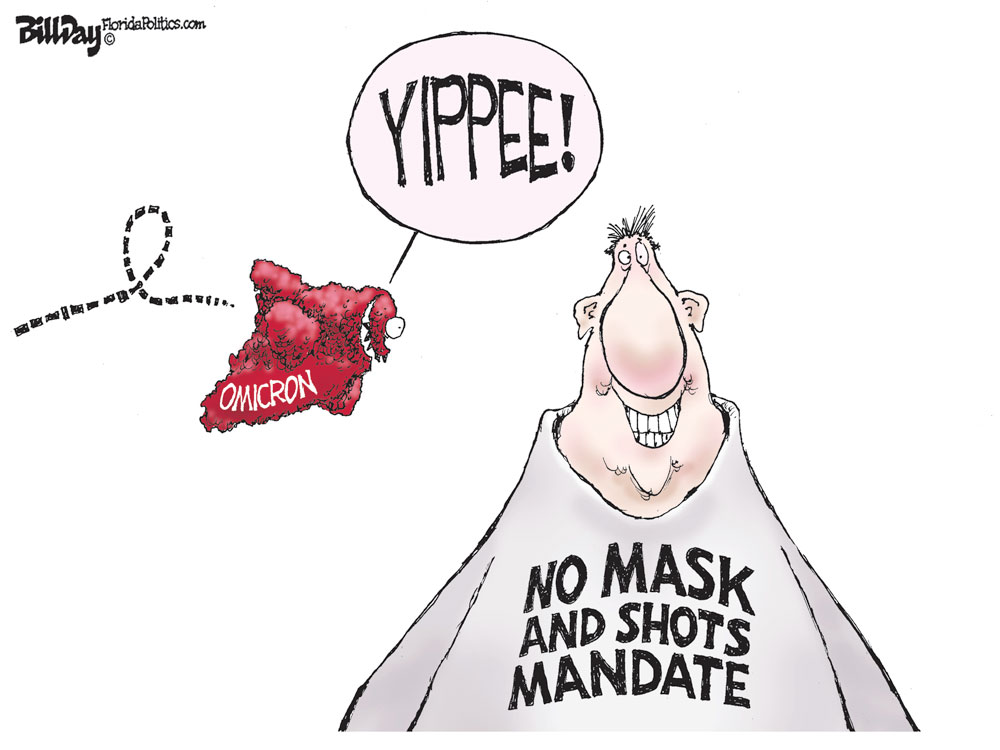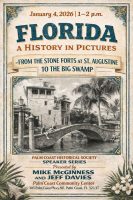
Today at the Editor’s glance: In Court: Michael McIntyre, who faces a capital murder charge in the death by drug overdose of Chelsea Price, 33, appears before Circuit Judge Terence Perkins at 1:30 p.m. for a possible plea. See: “Michael McIntyre, 35, Is Latest Flagler Resident Indicted for Murder in Overdose Death of a Client–Chelsea Price.” Palm Coast’s Beautification and Environmental Advisory committee meets bat 5 p.m. at City Hall. City Repertory Theatre stages Noel Coward’s “Blithe Spirit”, a staged reading, at 7:30 p.m. in CRT’s black box theater at City Marketplace, 160 Cypress Point Parkway, Suite B207, Palm Coast. Tickets are $20 adults and $15 students. Tickets are available online at eventbrite.com, by calling 386-585-9415, or at the venue just before showtime. Fussy, cantankerous novelist Charles Condomine, re-married but haunted (literally) by the ghost of his late first wife, the clever and insistent Elvira who is called up by a visiting happily wacky soothsayer, one Madame Arcati. A marvelously funny staged reading….just in time for Christmas. Stetson University School of Music’s Christmas Candlelight Concert is at 7:30 p.m. at Lee Chapel in Elizabeth Hall, 421 N. Woodland Blvd., DeLand. All seating is general admission. Doors open 45 minutes before each performance. Masks and physical distancing are required. Tickets are $40 with a $1 processing fee. Tonight’s performance is sold out.
![]()
The Live Calendar is a compendium of local and regional political, civic and cultural events. You can input your own calendar events directly onto the site as you wish them to appear (pending approval of course). To include your event in the Live Calendar, please fill out this form.
January 2026
Flagler Beach Farmers Market
Flagler Beach All Stars Beach Clean-Up
Coffee With Flagler Beach Commission Chair Scott Spradley
Grace Community Food Pantry on Education Way
Random Acts of Insanity Standup Comedy
ESL Bible Studies for Intermediate and Advanced Students
Grace Community Food Pantry on Education Way
Palm Coast Farmers’ Market at European Village
Florida: A History in Pictures, a Palm Coast Historical Society Speaker Series Lecture
Al-Anon Family Groups
For the full calendar, go here.

“But there has to be that interval of neglect, there has to be discontinuity; it is religiously and artistically essential. That is what I mean when I refer to the necessity for ruins: ruins provide the incentive for restoration, and for a return to origins. There has to be (in our new concept of history) an interim of death or rejection before there can be renewal and reform. The old order has to die before there can be a born-again landscape. Many of us know the joy and excitement not so much of creating the new as of redeeming what has been neglected, and this excitement is particularly strong when the original condition is seen as holy or beautiful. The old farmhouse has to decay before we can restore it and lead an alternative lifestyle in the country; the landscape has to be plundered and stripped before we can restore the natural ecosystem; the neighborhood has to be a slum before we can rediscover it and gentrify it. That is how we reproduce the cosmic scheme and correct history.”
–From “The Necessity of Ruins” by J.B. Jackson (1980).






































Ray W. says
Several decades ago, perhaps in the mid-’80’s, though I don’t exactly recall, I read of a conclusion reached by three French sociologists who had studied government policy documents and newspaper articles dating from the early 17th century to their present day. They concluded that government policies swung in what they defined as liberal and conservative cycles and predicted that a current conservative cycle would reach its peak in 2020, after which a liberal cycle of policies would begin to gain ascendency. If the French sociologists are right, perhaps the political ruin we see today is part of that cycle, with the liberal peak having occurred in the late ’60’s.
I discussed the article with my father, commenting that his generation of lawyers had come home from work each day asking themselves what they had accomplished to further the cause of individual rights, whereas my generation of lawyers was likely to wake up each morning wondering how they could hold back the rising tide against individual rights during the coming day, a diametrically opposed legal landscape.
Amidst the widespread discussions over yesterday’s arguments for and against upholding the individual rights precedent established by Roe v. Wade, J.B. Jackson’s blurb extracted from “The Necessity of Ruins” plucks a chord of memory, though I have commented on the French sociologists before. Thank you, Mr. Tristam.
Pierre Tristam says
Ray, Arthur Schlesinger Jr. in 1992 wrote a piece for the New Yorker, “The Turn of the Cycle,” proposing the same theory for American politics (and attributing the original idea to his father rather than to the French sociologists). The piece was written in the flush of Clinton’s ascendancy. I’m not sure it’s applied as convincingly as Schlesinger suggests: to my mind, to my memories, we seem to have been in a deep, and deepening, reactionary swing, that started deceptively with Nixon (everything was deceptive with that guy), accelerated with Reagan, who was the Thomas Acquinas of GOP ideology entirely and vengefully divorced from reality, then leading to the aberrations of Bush II, whose abandonment of all ethical and moral scruples stem-celled Trump. The Democrats in between seem to me interregnums of maladjusted idealism.
I would love to hear the harmonies that J.B. Jackson triggered Ray.
Ray W. says
So long as the Democratic Party keeps the porch light on for all who seek more progressive alternatives to an “ideology entirely and vengefully divorced from reality” there will be “periods of maladjusted idealism” among the many differing and competing factions of the Democratic Party.
Pogo says
@RE today’s quote, a pebble dropped in a still water and knowledge rippled from it.
“The way a city grows, the direction in which it spreads, is a factor not so much of zoning or real estate activity or land values but of highways.”
— J.B. Jackson
The more you know, the more you know. Or, in other words: READ FlaglerLive AND support it financially.
https://en.wikipedia.org/wiki/J._B._Jackson
Ray W. says
Hello Pogo,
One of my father’s most trusted friends was a major landowner in rural southeast Volusia County. Both my father and I represented the friend and later his son on many occasions.
I learned of a real estate transaction dating from the early ’50’s, in which the friend bought several hundred acres in the middle of nowhere for 25 cents per acre. An elderly attorney confirmed to me both the acreage and the monetary amount early in my career as we talked in a courtroom. My father’s friend had drawn a line on a map between New Smyrna Beach and DeLand. He then drew another line between Daytona Beach and Sanford. Marking the intersecting lines, he bought all the land he could at that intersection. Years later, S.R. 44 and C.R. 415 intersect right in the middle of his land. He built New Smyrna Speedway on the northwest corner. J.B. Jackson is right in recognizing the impact of roadways on development.
Then, there was the lawyer who represented a farmer who had been arrested by the feds for operating a moonshine still on his farm. The attorney’s fee to defend the farmer was the farm. At the time, the land was accessible via a dirt wagon path far from Port Orange. Today, a large upscale mobile home and golf community, Crane Lakes, is built on the former farm.
Some people see value where others see nothing more than a dirt wagon path.
One of the more interesting cases arising from the friend’s land holdings involved Florida’s 1976 “little EPA” act, which also impacted ITT’s huge land holdings in Flagler County. My father’s friend challenged the valuation of his rural land after the environmental protection act took effect. The county valued most of his land at $600 per acre. He filed suit, arguing it was worth $200 per acre. The case went up to Florida’s Supreme Court twice and was sent back with instructions each time. Around 1995, the dispute came up for hearing once again before a local circuit court judge. During the hearing, a recent land purchase by the county was introduced into evidence. The county had set the value of a large tract of neighboring rural land at $200 per acre before buying it. When the trial judge heard what the county had done, he asked the outside counsel who had been hired by the county to argue that the land was still worth $600 per acre a question: Just how much had the law firm been paid to argue that the land was worth $600 per acre? When the lawyer answered that his firm had received over $100,000 to make the argument, the trial judge immediately ruled that the land was worth $200 per acre. A nearly 20-year-long dispute resolved because one hand of the county did not know what the other hand was doing.
Ld says
:) cartoon sometimes a picture is worth a thousand words